View in other NatureServe Network Field Guides
NatureServe
Montana
Utah
Wyoming
Idaho
Wisconsin
British Columbia
South Carolina
Yukon
California
New York
Northern Redbelly X Finescale Dace - Chrosomus eos x Chrosomus neogaeus
State Rank Reason (see State Rank above)
Species relies on prairie streams and is found across limited portions of eastern Montana. It faces significant threats from the introduction of Northern Pike which can cause extirpation of local populations.
General Description
The Northern Redbelly hybrid is usually larger than the Northern Redbelly Dace and has a larger mouth extending almost to the eye. The Finescale Dace has never been recorded for this state.
For a comprehensive review of the ecology, conservation status, threats, and management of this and other Montana fish species of concern, please see
Montana Chapter of the American Fisheries Society Species of Concern Status Reviews.Diagnostic Characteristics
The midside stripe is less distinct than on the Northern Redbelly Dace (
Montana AFS Species Status Account), and its upper stripe is faint and usually broken.
There is no easy field technique to differentiate the dace hybrid from the Northern Redbelly Dace (Holton and Johnson 1996). According to William Gould, Emeritus Professor of Fisheries, Montana State University (2001), the hybrid dace can be differentiated from the Northern Redbelly Dace by pharyngeal teeth counts. Northern Redbelly Dace have pharyngeal tooth counts of 0, 5- 5, 0 and Finescale Dace has counts of 2, 5-4, 2. Hybrid
Phoxinus spp. have intermediate counts such as 1, 5-5, 1 or 1, 5-4, 1 or 1, 5-4, 0. New (1962) gives a detailed description of morphometric differences between the species (
Montana AFS Species Status Account).
Species Range
Montana Range
Range Descriptions
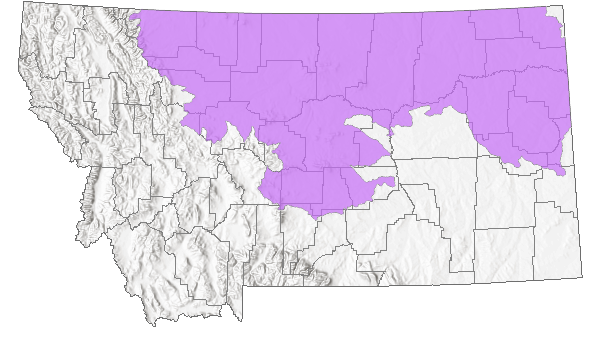
 Native
Native
Range Comments
In Montana, northern redbelly dace are fairly widespread east of the continental divide. Finescale dace have a similar range but distribution in the United States west of Minnesota is limited to glacial relict populations (Scott and Crossman 1973; Hubbs and Lagler 1970). Hybrids of the two species are found throughout New England west to Nebraska, Colorado and Montana and into Alberta (Dawley et al. 1987). There are no official records of finescale dace in the state (Holton and Johnson 1996). The finescale dace has been found in the Milk River drainage in the Cypress Hills, just over the Canadian border (Scott and Crossman 1973).
Observations in Montana Natural Heritage Program Database
Number of Observations: 96
(Click on the following maps and charts to see full sized version)
Map Help and Descriptions
Relative Density
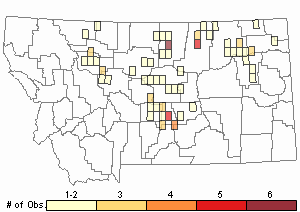
Recency
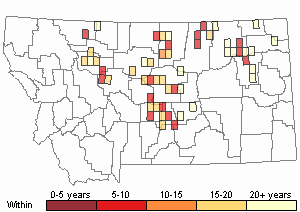

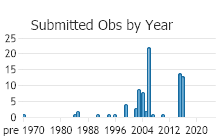
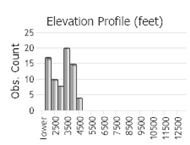 (Observations spanning multiple months or years are excluded from time charts)
(Observations spanning multiple months or years are excluded from time charts)
Habitat
Northern Redbelly Dace prefer quiet waters from beaver ponds, bogs, and clear streams (Scott and Crossman 1973, Holton and Johnson 1996). The Finescale Dace likes similar habitat but is also found in larger lakes (
Montana AFS Species Status Account).
Ecology
Schlosser et al. (1998) studied responses to environmental stresses on the hybrid, Finescale and Northern Redbelly Dace. He found that the hybrid had a greater physiological tolerance and survived longer in oxygen stressed environments than the other two species (
Montana AFS Species Status Account).
Reproductive Characteristics
The hybrid persists due to a unique strategy. Typically, hybrid females breed with Redbelly Dace males, but the male's genetic material is not incorporated during egg development and is not passed on to the next generation. The offspring are all female and clones of the mother (that is, they are genetically identical to the mother). Unisexuality is not common among vertebrates but has been found in amphibians and reptiles, as well as in fishes.
Two years of experiments on New England populations indicate that the hybrid dace utilize a unique reproductive strategy called gynogenesis (Dawley et al. 1987). The hybrid dace are female clones with identical eggs. In gynogenesis, sperm from the male of a sexually reproducing related species is needed to stimulate egg development, even though the genetic material is not incorporated into the offspring. Entire populations can have the same genes.
In Montana, preliminary studies indicate that at least two genetically distinct clones occur in the Pine Butte Fen (Allendorf 1991). Studies by Goddard et al. (1998) have shown that some female hybrid dace clones reproduce by cloning while other individuals make haploid eggs that can be fertilized by Northern Redbelly Dace to produce diploid Northern Redbelly Dace offspring.
Phoxinus spp. spawn in the spring and early summer (Scott and Crossman 1973,
Montana AFS Species Status Account).
Management
The Northern Redbelly x Finescale Dace hybrid (
Phoxinus eos x
P. neogaeus) is a Montana Fish Species of Special Concern, Class C (Hunter 1997). It was placed on the species of concern list due to its rarity and unusual form of genetic reproduction (Holton and Johnson 1996). Montana appears to be the only state that designates special status for this hybrid fish (
Montana AFS Species Status Account).
Further inventory is needed to better define
Phoxinus spp. distribution in Montana. Due to difficulties of field differentiation, it is likely that some waters thought to contain only Northern Redbelly Dace may also have the hybrid.
Phoxinus spp. are not extremely common in Montana. Bramblett and Zale (2000) have conducted surveys on 43 prairie streams of the Missouri and Yellowstone rivers and identified
Phoxinus spp. at just three sites, one of which contained the hybrid. Few prairie streams in Montana have the clear pool-type habitat preferred by
Phoxinus spp. Due to the limited distribution and knowledge of this species it is important to reduce impacts to their known habitat, such as is described for Big Coulee Creek, Montana (Palmer 1994,
Montana AFS Species Status Account).
Stewardship Responsibility
References
- Literature Cited AboveLegend:
 View Online Publication
View Online Publication Allendorf, F.W. 1991. Letter to David Carr re: Pine Butte Swamp Preserve and dace analysis. Missoula, MT: University of Montana. 6 September 1991.
Allendorf, F.W. 1991. Letter to David Carr re: Pine Butte Swamp Preserve and dace analysis. Missoula, MT: University of Montana. 6 September 1991. Bramblett, R. G. and A. V. Zale. 2000. The ichthyofauna of small streams on the Charles M. Russell National Wildlife Refuge, Montana. Intermountain Journal of Sciences 6:57-67.
Bramblett, R. G. and A. V. Zale. 2000. The ichthyofauna of small streams on the Charles M. Russell National Wildlife Refuge, Montana. Intermountain Journal of Sciences 6:57-67. Goddard, K., O. Megwinoff, L. Wessner, and F. Giaimo. 1998. Confirmation of gynogenesis in Phoxinus eos-neogaeus (Pisces: Cyprinidae). Journal of Heredity 89 (2): 151-157.
Goddard, K., O. Megwinoff, L. Wessner, and F. Giaimo. 1998. Confirmation of gynogenesis in Phoxinus eos-neogaeus (Pisces: Cyprinidae). Journal of Heredity 89 (2): 151-157. Gould, W. R. 2001. Emeritus Professor of Fisheries, Montana State University. Letter dated March 12, 2001.
Gould, W. R. 2001. Emeritus Professor of Fisheries, Montana State University. Letter dated March 12, 2001. Holton, G. D. and H. E. Johnson. 1996. A field guide to Montana fishes. Second Edition. Montana Department of Fish, Wildlife and Parks, Helena. 104 pp.
Holton, G. D. and H. E. Johnson. 1996. A field guide to Montana fishes. Second Edition. Montana Department of Fish, Wildlife and Parks, Helena. 104 pp. Hunter, C. 1997. Fishes of special concern: an update. Montana Outdoors (November/December): 26–27.
Hunter, C. 1997. Fishes of special concern: an update. Montana Outdoors (November/December): 26–27. Lee, D.S., C.R. Gilbert, C.H. Hocutt, R.E. Jenkins, D. E. McAllister, J. R. Stauffer, Jr. 1980. Atlas of North American freshwater fishes. North Carolina State Musuem of Natural History. 867 p.
Lee, D.S., C.R. Gilbert, C.H. Hocutt, R.E. Jenkins, D. E. McAllister, J. R. Stauffer, Jr. 1980. Atlas of North American freshwater fishes. North Carolina State Musuem of Natural History. 867 p. Montana Chapter of the American Fisheries Society species status accounts.
Montana Chapter of the American Fisheries Society species status accounts. Palmer, T. 1994. The wonder minnow. Montana Outdoors (July/August): 42-43.
Palmer, T. 1994. The wonder minnow. Montana Outdoors (July/August): 42-43. Schlosser, I. J, M. R. Doeringsfeld, J. F. Elder, and L. F. Arzayus. 1998. Niche relationships of clonal and sexual fish in a heterogeneous landscape. Ecology 79 (3): 953.
Schlosser, I. J, M. R. Doeringsfeld, J. F. Elder, and L. F. Arzayus. 1998. Niche relationships of clonal and sexual fish in a heterogeneous landscape. Ecology 79 (3): 953. Scott, W.B. and E.J. Crossman. 1973. Rainbow trout, Kamloops trout, Steelhead trout Salmo gairdneri Richardson. pp. 184-191. In: Freshwater fishes of Canada. Ottawa, Canada: Fisheries Research Board of Canada, Bulletin 184. 966 p.
Scott, W.B. and E.J. Crossman. 1973. Rainbow trout, Kamloops trout, Steelhead trout Salmo gairdneri Richardson. pp. 184-191. In: Freshwater fishes of Canada. Ottawa, Canada: Fisheries Research Board of Canada, Bulletin 184. 966 p.
- Additional ReferencesLegend:
 View Online Publication
View Online Publication
Do you know of a citation we're missing? Allendorf, F.W. 1991. All-female species of fish at Pine Butte Preserve. Missoula, MT: University of Montana. News from Pine Butte. p. 6.
Allendorf, F.W. 1991. All-female species of fish at Pine Butte Preserve. Missoula, MT: University of Montana. News from Pine Butte. p. 6. Dawley, R.M. And K.A. Goddard. 1988. Diploid-triploid mosaics among unisexual hybrids of the minnows Phoxinus eos and Phoxinus neogaeus. Evolution 42(4):649-659.
Dawley, R.M. And K.A. Goddard. 1988. Diploid-triploid mosaics among unisexual hybrids of the minnows Phoxinus eos and Phoxinus neogaeus. Evolution 42(4):649-659. Dawley, R.M., R.J. Schultz, and K.A. Goddard. 1987. Clonal reproduction and polyploidy in unisexual hybrids of Phoxinus eos and Phoxinus neogaeus (Pisces: Cyprinidae). Copeia 1987:275-283.
Dawley, R.M., R.J. Schultz, and K.A. Goddard. 1987. Clonal reproduction and polyploidy in unisexual hybrids of Phoxinus eos and Phoxinus neogaeus (Pisces: Cyprinidae). Copeia 1987:275-283. Joslin, Gayle, and Heidi B. Youmans. 1999. Effects of recreation on Rocky Mountain wildlife: a review for Montana. [Montana]: Montana Chapter of the Wildlife Society.
Joslin, Gayle, and Heidi B. Youmans. 1999. Effects of recreation on Rocky Mountain wildlife: a review for Montana. [Montana]: Montana Chapter of the Wildlife Society. Joswiak, G. R., R. H. Stasiak, and W. S. Moore. 1982. Allozyme analysis of the hybrid Phoxinus eos X Phoxinus neogaeus (Pices: Cyprinidae) in Nebraska. Can. J. Zool. Vol. 60:968-972.
Joswiak, G. R., R. H. Stasiak, and W. S. Moore. 1982. Allozyme analysis of the hybrid Phoxinus eos X Phoxinus neogaeus (Pices: Cyprinidae) in Nebraska. Can. J. Zool. Vol. 60:968-972. New, J.G. 1962. Hybridization between two Cyprinids, Chrosomus eos and Chrosomus neogaeus. Copeia (1):147-152.
New, J.G. 1962. Hybridization between two Cyprinids, Chrosomus eos and Chrosomus neogaeus. Copeia (1):147-152.
- Web Search Engines for Articles on "Northern Redbelly X Finescale Dace"
- Additional Sources of Information Related to "Fish"





